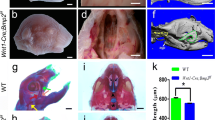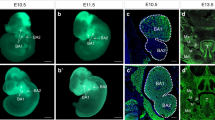Abstract
As the major receptor mediated BMP signaling in craniofacial development, Bmpr1a expression was detected in the anterior palatal shelves from E13.5 and the posterior palatal shelves from E14.5. However, inactivating BMP receptor in the mesenchyme only leads to anterior cleft palate or submucous cleft palate. The role of BMP signaling in posterior palatal mesenchyme and palatal osteogenesis is still unknown. In this study, a secreted BMP antagonist, Noggin was over-expressed by Osr2-creKI to suppress BMP signaling intensively in mouse palatal mesenchyme, which made the newborn mouse displaying complete cleft palate, a phenotype much severer than the anterior or submucous cleft palate. Immunohistochemical analysis indicated that in the anterior and posterior palatal mesenchyme, the canonical BMP-Smad4 signaling was dramatically down-regulated, while the non-canonical BMP signaling pathways were altered little. Although cell proliferation was reduced only in the anterior palatal mesenchyme, the osteogenic condensation and Osterix distribution were remarkably repressed in the posterior palatal mesenchyme by Noggin over-expression. These findings suggested that BMP-Smad4 signaling was essential for the cell proliferation in the anterior palatal mesenchyme, and for the osteogenesis in the posterior palatal mesenchyme. Interestingly, the constitutive activation of Bmpr1a in palatal mesenchyme also caused the complete cleft palate, in which the enhanced BMP-Smad4 signaling resulted in the premature osteogenic differentiation in palatal mesenchyme. Moreover, neither the Noggin over-expression nor Bmpr1a activation disrupted the elevation of palatal shelves. Our study not only suggested that BMP signaling played the differential roles in the anterior and posterior palatal mesenchyme, but also indicated that BMP-Smad4 signaling was required to be finely tuned for the osteogenesis of palatal mesenchyme.












Similar content being viewed by others
References
Baek JA, Lan Y, Liu H, Maltby KM, Mishina Y, Jiang R (2011) Bmpr1a signaling plays critical roles in palatal shelf growth and palatal bone formation. Dev Biol 350:520–531
Berendsen AD, Olsen BR (2015) Bone development. Bone 80:14–18
Bragdon B, Moseychuk O, Saldanha S, King D, Julian J, Nohe A (2011) Bone morphogenetic proteins: a critical review. Cell Signal 23:609–620
Bush OJ, Jiang R (2012) Palatogenesis: morphogenetic and molecular mechanisms of secondary palate development. Development 139:231–243
Celá P, Buchtová M, Veselá I, Fu K, Bogardi JP, Song Y, Barlow A, Buxton P, Medalová J, Francis-West P, Richman JM (2016) BMP signaling regulates the fate of chondro-osteoprogenitor cells in facial mesenchyme in a stage-specific manner. Dev Dyn 245:947–962
Chai Y, Jiang X, Ito Y, Bringas P Jr, Han J, Rowitch DH, Soriano P, McMahon AP, Sucov HM (2000) Fate of the mammalian cranial neural crest during tooth and mandibular morphogenesis. Development 127:1671–1169
Chen J, Lan Y, Baek JA, Gao Y, Jiang RL (2009) Wnt/beta-catenin signaling plays an essential role in activation of odontogenic mesenchyme during early tooth development. Dev Biol 334:174–185
Chen X, Liu J, Li N, Wang Y, Zhou N, Zhu L, Shi Y, Wu Y, Xiao J, Liu C (2019) Mesenchymal Wnt/β-catenin signaling induces Wnt and BMP antagonists in dental epithelium. Organogenesis 15:55–67
Chen Y, Wang Z, Chen Y, Zhang Y (2019) Conditional deletion of Bmp2 in cranial neural crest cells recapitulates Pierre Robin sequence in mice. Cell Tissue Res 376:199–210
Correia AC, Costa M, Moraes F, Bom J, Nóvoa A, Mallo M (2007) Bmp2 is required for migration but not for induction of neural crest cells in the mouse. Dev Dyn 236:2493–2501
Dixon MJ, Marazita ML, Beaty TH, Murray JC (2011) Cleft lip and palate: understanding genetic and environmental influences. Nat Rev Genet 12:167–178
Ito Y, Yeo JY, Chytil A, Han J, Bringas P Jr, Nakajima A, Shuler CF, Moses HL, Chai Y (2003) Conditional inactivation of Tgfbr2 in cranial neural crest causes cleft palate and calvaria defects. Development 130:5269–5280
Dudas M, Sridurongrit S, Nagy A, Okazaki K, Kaartinen V (2004) Craniofacial defects in mice lacking BMP type I receptor Alk2 in neural crest cells. Mech Dev 121:173–182
Ferguson MW (1988) Palate development. Development 103 Suppl:41–60
Graf D, Malik Z, Hayano S, Mishina Y (2016) Common mechanisms in development and disease: BMP signaling in craniofacial development. Cytokine Growth Factor Rev 27:129–139
He F, Xiong W, Wang Y, Matsui M, Yu X, Chai Y, Klingensmith J, Chen Y (2010) Modulation of BMP signaling by Noggin is required for the maintenance of palatal epithelial integrity during palatogenesis. Dev Biol 347:109–121
Jia S, Zhou J, Gao Y, Baek JA, Martin JF, Lan Y, Jiang R (2013) Roles of Bmp4 during tooth morphogenesis and sequential tooth formation. Development 140:423–432
Jiang T, Ge S, Shim YH, Zhang C, Cao D (2015) Bone morphogenetic protein is required for fibroblast growth factor 2-dependent later-stage osteoblastic differentiation in cranial suture cells. Int J Clin Exp Pathol 28:2946–2954
Komatsu Y, Yu PB, Kamiya N, Pan H, Fukuda T, Scott GJ, Ray MK, Yamamura K, Mishina Y (2013) Augmentation of Smad-dependent BMP signaling in neural crest cells causes craniosynostosis in mice. J Bone Miner Res 28:1422–1433
Kouskoura T, Kozlova A, Alexiou M, Blumer S, Zouvelou V, Katsaros C, Chiquet M, Mitsiadis TA, Graf D (2013) The etiology of cleft palate formation in BMP7-deficient mice. PLoS One 8:e59463
Kouskoura T, El Fersioui Y, Angelini M, Graf D, Katsaros C, Chiquet M (2016) Dislocated Tongue Muscle Attachment and Cleft Palate Formation. J Dent Res 95:453–439
Krause C, Guzman A, Knaus P (2011) Noggin. Int J Biochem Cell Biol 43:478–481
Lai Y, Xie C, Zhang S, Gan G, Wu D, Chen W (2016) Bone morphogenetic protein type I receptor inhibition induces cleft palate associated with micrognathia and cleft lower lip in mice. Birth Defects Res A Clin Mol Teratol 106:612–623
Lan Y, Wang Q, Ovitt CE, Jiang R (2007) A unique mouse strain expressing Cre recombinase for tissue-specific analysis of gene function in palate and kidney development. Genesis 45:618–624
Lana-Elola E, Tylzanowski P, Takatalo M, Alakurtti K, Veistinen L, Mitsiadis TA, Graf D, Rice R, Luyten FP, Rice DP (2011) Noggin null allele mice exhibit a microform of holoprosencephaly. Hum Mol Genet 20:4005–4015
Li L, Lin M, Wang Y, Cserjesi P, Chen Z, Chen Y (2011) BmprIa is required in mesenchymal tissue and has limited redundant function with BmprIb in tooth and palate development. Dev Biol 349:451–461
Li C, Lan Y, Jiang R (2017) Molecular and Cellular Mechanisms of Palate Development. J Dent Res 96:1184–1191
Li L, Wang Y, Lin M, Yuan G, Yang G, Zheng Y, Chen Y (2013) Augmented BMPRIA-mediated BMP signaling in cranial neural crest lineage leads to cleft palate formation and delayed tooth differentiation. PLoS One 8:e66107
Li X, Cao X (2006) BMP signaling and skeletogenesis. Ann N Y Acad Sci 1068:26–40
Miyazono K, Maeda S, Imamura T (2005) BMP receptor signaling: transcriptional targets, regulation of signals, and signaling cross-talk. Cytokine Growth Factor Rev 16:251–263
Mossey PA, Modell B (2012) Epidemiology of oral clefts 2012: an international perspective. Front Oral Biol 16:1–18
Nie X, Luukko K, Kettunen P (2006) BMP signalling in craniofacial development. Int J Dev Biol 50:511–521
Nifuji A, Noda M (1999) Coordinated expression of noggin and bone morphogenetic proteins (BMPs) during early skeletogenesis and induction of noggin expression by BMP-7. J Bone Miner Res 14:2057–2066
Nifuji A, Kellermann O, Noda M (2004) Noggin inhibits chondrogenic but not osteogenic differentiation in mesodermal stem cell line C1 and skeletal cells. Endocrinology 145:3434–3442
Noda K, Mishina Y, Komatsu Y (2016) Constitutively active mutation of ACVR1 in oral epithelium causes submucous cleft palate in mice. Dev Biol 415:306–313
Pan H, Zhang H, Abraham P, Komatsu Y, Lyons K, Kaartinen V, Mishina Y (2017) BmpR1A is a major type 1 BMP receptor for BMP-Smad signaling during skull development. Dev Biol 429:260–270
Parada C, Li J, Iwata J, Suzuki A, Chai Y (2013) CTGF mediates Smad-dependent transforming growth factor β signaling to regulate mesenchymal cell proliferation during palate development. Mol Cell Bio 33:3482–3493
Parada C, Han D, Grimaldi A, Sarrión P, Park SS, Pelikan R, Sanchez-Lara PA, Chai Y (2015) Disruption of the ERK/MAPK pathway in neural crest cells as a potential cause of Pierre Robin sequence. Development 142:3734–3745
Saito H, Yamamura K, Suzuki N (2012) Reduced bone morphogenetic protein receptor type 1A signaling in neural-crest-derived cells causes facial dysmorphism. Dis Model Mech 5:948–955
Satokata I, Maas R (1994) Msx-1 deficient mice exhibit cleft palate and abnormalities of craniofacial and tooth development. Na Genet 6:348–356
Song Z, Liu C, Iwata J, Gu S, Suzuki A, Sun C, He W, Shu R, Li L, Chai Y, Chen Y (2013) Mice with Tak1 deficiency in neural crest lineage exhibit cleft palate associated with abnormal tongue development. J Biol Chem 288:10440–10450
Stuppia L, Capogreco M, Marzo G, La Rovere D, Antonucci I, Gatta V, Palka G, Mortellaro C, Tetè S (2011) Genetics of syndromic and nonsyndromic cleft lip and palate. J Craniofac Surg 22:1722–1726
Szabó A, Mayor R (2018) Mechanisms of neural crest migration. Annu Rev Genet 52:43–63
Wang W, Zhou C, Feng Z, Li H, Zhang Y, Bao B, Cai B, Chen M, Huang H (2019) PLGA-based control release of Noggin blocks the premature fusion of cranial sutures caused by retinoic acid. Appl Microbiol Biotechnol 103:291–301
Wu W, Gu S, Sun C, He W, Xie X, Li X, Ye W, Qin C, Chen Y, Xiao J, Liu C (2015) Altered FGF signaling pathways impair cell proliferation and elevation of palate shelves. PLoS ONE 10:e0136951
Xiong W, He F, Morikawa Y, Yu X, Zhang Z, Lan Y, Jiang R, Cserjesi P, Chen YP (2009) Hand2 is required in the epithelium for palatogenesis in mice. Dev Biol 330:131–141
Yu X, Kawakami H, Tahara N, Olmer M, Hayashi S, Akiyama R, Bagchi A, Lotz M, Kawakami Y (2017) Expression of Noggin and Gremlin1 and its implications in fine-tuning BMP activities in mouse cartilage tissues. J Orthop Re 35:1671–1682
Yumoto K, Thomas PS, Lane J, Matsuzaki K, Inagaki M, Ninomiya-Tsuji J, Scott GJ, Ray MK, Ishii M, Maxson R, Mishina Y, Kaartinen V (2013) TGF-β-activated kinase 1 (Tak1) mediates agonist-induced Smad activation and linker region phosphorylation in embryonic craniofacial neural crest-derived cells. J Biol Chem 288:13467–13480
Zhang Y, Que J (2019) BMP signaling in development, stem cells, and diseases of the gastrointestinal tract. Annu Rev Physiol 82:251–273
Zhang Z, Song Y, Zhao X, Zhang X, Fermin C, Chen Y (2002) Rescue of cleft palate in Msx1-deficient mice by transgenic Bmp4 reveals a network of BMP and Shh signaling in the regulation of mammalian palatogenesis. Development 129:4135–4146
Zou H, Wieser R, Massagué J, Niswander L (1997) Distinct roles of type I bone morphogenetic protein receptors in the formation and differentiation of cartilage. Genes Dev 11:2191–2203
Funding
This work was supported by National Natural Science Foundation of China (Grant Numbers: 81771055 and 81970922).
Author information
Authors and Affiliations
Corresponding author
Ethics declarations
Ethical approval
All the experimental procedures involving mice were performed according to the NIH Guideline for the Care and Use of Laboratory Animals (NIH Publication, 8th Edition. Revised 2011). The protocol was inspected and approved by the Animal Care and Use Committee at Dalian Medical University (Approval NO. AEE17038).
Conflict of interest
On behalf of all authors, the corresponding author states that there is no conflict of interest.
Electronic supplementary material
Below is the link to the electronic supplementary material.
Supplementary Fig. 1
The appearance of Wnt1-cre;pMes-Noggin and Osr2-creKI;pMes-Noggin mice. The black arrow and triangle in (a) indicated the ear and eye, respectively; the red triangle in (b) indicated the truncated forelimb bud. The red arrows in c-f indicated the mandibles; the black triangle in (d) pointed to the open eyelid. (TIF 6085 kb)
Supplementary Fig. 2
The appearance of Osr2-creKI;pMes-caBmpr1a mice. The white and black arrows in a-d indicated the mandibles. (TIF 4763 kb)
Rights and permissions
About this article
Cite this article
Li, N., Liu, J., Liu, H. et al. Altered BMP-Smad4 signaling causes complete cleft palate by disturbing osteogenesis in palatal mesenchyme. J Mol Histol 52, 45–61 (2021). https://doi.org/10.1007/s10735-020-09922-4
Received:
Accepted:
Published:
Issue Date:
DOI: https://doi.org/10.1007/s10735-020-09922-4




